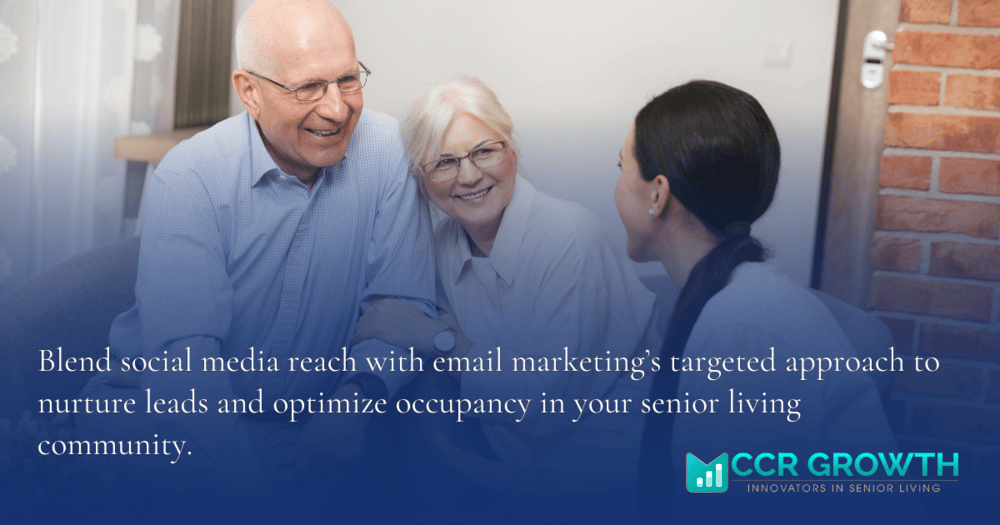
CCR Growth
Do You Really Need Social Media, or Is Email Marketing Enough?
In senior living marketing, the channels you choose to reach prospective residents—and their families—can make all the difference in your census numbers. At CCR Growth, we often encounter clients who wonder whether social media is truly necessary for their senior living community’s marketing strategy, or if email marketing alone can carry enough weight to fill those beds and maintain high occupancy.
While both email marketing and social media marketing can prove highly effective, the question isn’t about whether one channel definitively outperforms the other. Rather, senior living operators need to pinpoint the specific contexts in which each platform excels, and how these channels can work together for maximum impact. In this blog post, we’ll explore both sides of the argument and then provide a conclusion about the ideal approach for senior living communities.

The Case for Email Marketing
Email marketing remains a cornerstone of digital outreach for senior living communities. In fact, the Hubspot’s State of Marketing Report 2024 shows that email marketing came out tops for B2C marketing ROI. This comes as no surprise since by delivering tailored messages directly into subscribers’ inboxes, you can offer meaningful information to prospective residents, their families, and other stakeholders.Control Over Your Audience
One of the biggest strengths of email marketing is direct access to an audience that has already demonstrated an interest in your community. Whether they’re existing residents’ family members, prospective residents, or local stakeholders in your senior living community, these recipients have opted in to receive messages from you. This “opt-in” factor ensures higher engagement rates and a level of control that is hard to replicate on social media platforms.Furthermore, email marketing campaigns aren’t subject to the ever-changing algorithms that social media platforms employ. When you send an email, it lands in the recipient’s inbox—bypassing the typical feed filters that can hide your content on social networks.If your email strategy and segmentation are done correctly (e.g., personalizing by user personas, including family members versus the seniors themselves, or even by the level of care they’re interested in, such as independent living vs. memory care), you can almost guarantee that your carefully crafted message reaches a relevant audience.Marketing Automation and A/B Testing
Email marketing platforms offer sophisticated tools for automation and testing. This is particularly impactful for senior living communities that juggle multiple audience segments, inquiries, and follow-up schedules.For example, after a potential resident downloads a brochure, you can automatically trigger an onboarding sequence that sends targeted information about your community’s services, amenities, and success stories. Meanwhile, for current families, an automated sequence can share updates on seasonal events, policy changes, or new wellness programs.Additionally, A/B testing allows you to experiment with subject lines, content layouts, and messaging tones. This granular level of testing can help you pinpoint exactly which type of messaging resonates with different personas—something that can be particularly valuable when you consider how varied the senior living audience can be (adult children, older adults themselves, physicians, and healthcare networks all might receive different emails).ROI and Measurement
The return on investment (ROI) for email marketing tends to be exceptionally high. In fact, according to a global marketing survey in 2020, brands saw a return of $36 for every U.S. dollar they invested in email marketing. Emails are also relatively inexpensive to create and send, and detailed tracking allows you to see open rates, click-through rates (CTRs), and conversions in real-time. This is particularly important in senior living, where the sales cycle can stretch over months (or even years). By tracking engagement with emails over time, your marketing team can better forecast occupancy rates, plan follow-ups, and build relationships.But how do you build your email lists in the first place? It’s likely this question has crossed your mind. That’s where the need for a cross-over with social media marketing comes into play. Meeting your audiences where they’re hanging out (on specific social media platforms, for example) is a good start to building that email list.The Case for Social Media Marketing
Social media platforms like Facebook, Instagram, and LinkedIn have become indispensable tools for senior living communities looking to boost their online presence. Beyond brand awareness, social media fosters deeper engagement through conversations, storytelling, and community-building. Below, we examine how these platforms can amplify your reach and keep your community top-of-mind among prospective residents and their families.Broad Reach and Brand Awareness
Social media allows you to broadcast your message to a wide audience—many of whom might not yet be on your email list. Since adult children often spend time researching senior living options for their parents, platforms like Facebook and Instagram become indispensable channels for brand awareness. Your community’s presence on these platforms helps you appear credible, accessible, and transparent, which can heavily influence how a family perceives your offerings.Moreover, virality is an important aspect to consider. A single post highlighting a success story or a resident’s milestone birthday celebration can get shared among friends and family, significantly expanding your reach. In contrast, an email has limited “sharing” potential—unless the recipient decides to forward it.Community Building
Social media isn’t just about broadcasting; it’s about community building. Senior living communities thrive when they can show real-time snapshots of daily life to prospective residents and families. Photos of residents participating in activities, short videos featuring staff members who genuinely care, or live streams of community events can forge an emotional connection that builds trust. The trick is to remain responsive, ready to answer questions and interact with your audience in order to foster healthy community engagement.From a technical standpoint, social media platforms like Facebook provide comprehensive analytics dashboards, including demographic breakdowns, post engagement statistics, and traffic referral data. These analytics allow a deep dive into who your content is resonating with—helping you tailor your messaging for maximum impact. Even more sophisticated targeting options are available when you venture into paid social media advertising, enabling you to show your content to highly specific age groups, income ranges, and geographic areas.Lead Generation and Retargeting
From a purely technical standpoint, social media can be a powerhouse for lead generation and retargeting. Through platforms like Facebook and Instagram, you can set up targeted ad campaigns with pixel tracking. Once a prospect visits your website or landing page, you can retarget them with relevant messages, such as a short video tour of the memory care wing, or a testimonial from a family who recently moved their loved one into your community.The Facebook Pixel, for example, allows you to track user behavior on your website, ensuring you only spend ad budget on individuals who’ve already shown some interest in your community. This level of precise targeting can speed up the senior living sales cycle by keeping your brand top-of-mind through repeated exposures, reinforcing the trust factor and moving prospects closer to scheduling a tour.Why Relying on Just One Channel May Be Short-Sighted
Although both email marketing and social media have distinct advantages, relying on just one channel could limit your ability to reach and engage your audience. Below, we explore how a multi-channel approach ensures no potential lead slips through the cracks—whether it’s the adult child doing preliminary research on Facebook or the senior prospect responding to a personalized email.Addressing Different Audience Preferences
One of the most important insights in senior living marketing is that different demographics respond to different channels. While some seniors are tech-savvy enough to use email and social platforms, others might be more responsive to phone calls or printed mailers.Family members in their 40s, 50s, and 60s might spend considerable time on Facebook or LinkedIn. Relying solely on email might mean you’re missing out on connecting with these individuals where they spend their digital time. Conversely, focusing purely on social media could mean losing the deeper engagement that comes from personalized email campaigns.Multi-Touchpoint Strategy
Senior living communities often face a long sales cycle. A prospective resident doesn’t just wake up one day and move in. There are tours, financial considerations, discussions with family members, assessments for the level of care, and waiting lists, among other factors.A multi-channel approach—where email and social media are both used strategically—ensures that you’re creating multiple touchpoints throughout this journey. One day, a prospective family member might see an inspiring post about your community on Facebook; the next, they might receive a well-timed email about an upcoming open house. These sequential touches can guide them more smoothly through their decision process.Consistent Branding
Each platform—email and social—presents a chance to reinforce your brand identity. By aligning your messaging across both channels, you create a cohesive story that resonates. Use consistent brand elements (color palette, logo, tone of voice) and a unified message (e.g., your community’s emphasis on quality of care, vibrant lifestyle, or family involvement). When done well, this synergy makes a senior living community look professional, trustworthy, and transparent.
Using Data to Optimize Your Strategy
A growing trend among successful senior living communities is the adoption of marketing automation systems. These platforms integrate email marketing, social media scheduling, and customer relationship management (CRM) data to provide a holistic view of how prospects interact with your brand.You can:- Automate cross-channel campaigns so that, for instance, a lead nurtured on social media gets enrolled in an email drip sequence when they download a brochure from your Facebook ad.
- Analyze attribution: Did they ultimately schedule a tour after receiving a particular email or after clicking a social media ad? This insight allows you to shift budget and focus to where you see the best returns.
- Alter your communication approach if someone consistently interacts with your social media posts but never opens an email—possibly by sending a more personalized or less frequent email campaign, or by focusing on retargeting them via social platforms.
The Bottom Line? You Need Both
The debate about whether social media or email marketing is superior often rests on the false premise that one must overshadow the other. In reality, for senior living communities aiming for peak occupancy and robust brand reputation, a synergy of both channels is essential. Each platform addresses a different aspect of engagement and reaches different types of decision-makers at different points in their journey.At CCR Growth, we specialize in optimizing marketing, sales, and operations for senior living communities. Our holistic approach ensures you’re leveraging every suitable channel (including email, social media, and beyond) to maintain peak occupancy. By striking the right balance and using advanced marketing tools and analytics to track performance, you can develop a strategy that speaks to every stakeholder, from current and future residents to their extended families and caregivers.Ready to refine your senior living marketing strategy? Reach out to CCR Growth to discuss how our integrated approach can support your community’s growth and success—on social media, via email, and beyond.Subscribe to our newsletter
Sharpen your expertise and stay ahead of senior living industry trends—subscribe to CCR Growth’s newsletter for exclusive insights and updates.
Recent Posts


How Senior Living Solves the Family Caregiving Crisis and Improves Quality of Life

Redefining Senior Living Marketing, Sales, and Operations
CONTACT ADDRESS
8710 Carmel Valley Road, Carmel, CA 93923
GENERAL INQUIRIES
info@ccrgrowth.com
(831) 273-3628
SOCIAL MEDIA




